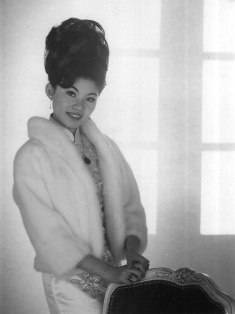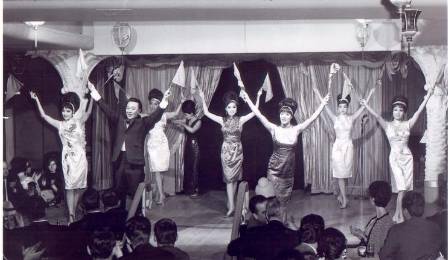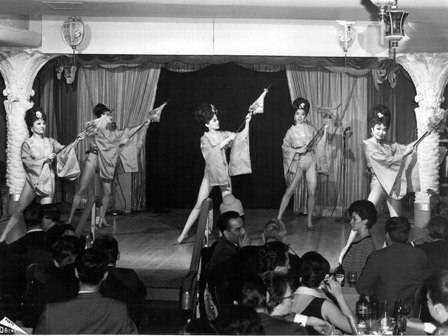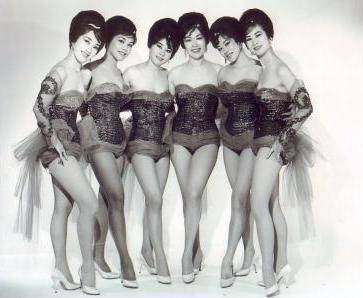Cynthia Yee
Historical Essay
by Kristin Morris, San Francisco Museum and Historical Society
"Miss Chinatown 1967"
Image: Courtesy of Cynthia Yee
Cynthia Yee was born and raised in San Francisco, the youngest of four children. As a child, she lived in the same apartment building as noted Japanese-American dancer Dorothy Toy. She recalls how Dorothy helped her get into show business, “At the age of 9 years old, I was so inspired by her that she sent me to ballet school. And I went to the ballet school that she was talking ballet from, Serge Tennoff, who was a Russian teacher here in San Francisco, and I guess I took about 98 years of ballet, and then I joined Dorothy’s show, and that’s how it all began.”
In the mid-1960s, Dorothy Toy was producing an all-Asian floorshow at Andy Wong’s Chinese Skyroom, one of the most popular nightclubs in San Francisco’s Chinatown. Cynthia recalls her first time on stage, “I was seventeen, right out of high school and it was in the summer, right after graduation. Dorothy gave me a phone call and said, 'I really need help. One of the girls got very ill and I need a dancer.' And I said, 'But I’m not 21 what do I do?' because they were playing at the Chinese Skyroom at that time. She said, ‘We’ll sneak you in. We have no choice.’ And that was it. In the beginning of course everybody always said, 'Why do you let your daughter be in show business?' and Dorothy told my mom that she would take care of me, and she did. Because I was in Dorothy Toy’s show and my mother knew Dorothy as a personal friend, it was fine.” In 1967, she won the prestigious Miss Chinatown crown, performing a dance choreographed by Dorothy Toy.
Cynthia's career came just at the tail end of the golden age of Chinese nightclubs. By the late 1960s, the nightclub scene in San Francisco had been transformed. The success of Carol Doda and the strip clubs on Broadway forced many nightclub owners to incorporate more stripping and exotic dancing into their shows. The Chinese nightclubs were no exception. In this heavily competitive field, Chinese nightclub owners marketed the unique “Oriental” shows featuring “China Dolls” in seductive costumes. The Chinese strip shows were still quite tame compared to some in the city; performers typically stripped down to a bikini with generous coverage.
Dorothy Toy's Oriental Review at the Chinese Skyroom, c1966. Cynthia Yee is in the center back row, Dorothy Toy is right of center in the front row.
Image: Courtesy of Cynthia Yee
Dorothy Toy's Oriental Review at the Chinese Skyroom, c1966. The Kimono Number included a tame striptease.
Image: Courtesy of Cynthia Yee
Cynthia performed with Dorothy Toy's act at the Chinese Skyroom for about one year before the nightclub closed. Cynthia explains the transition, “At that time nightclubs were getting passé, 1963. So Dorothy took the show on the road, and we traveled throughout the United States, Canada, Caribbean, South America, and then on to Europe and Japan. In our opening number, we had authentic Chinese costumes from the Chinese opera, and very heavy headdresses all sequined, all embroidered, beautiful… and then Dorothy would either have the costumer or have her mother at that time, cut up all the costumes to make it very commercial and very sexy and very attractive. That‘s what we were known for -- a lot of legs. At that time you have to remember, the nightclub’s gone, people didn’t know what nightclubs were, and then the traditional Chinese dance comes, very traditional, very conservative, almost looking like wearing pajamas and then out comes Dorothy Toy in her fancy sequined outfits all cut up to show legs -- that was really something.” Cynthia also recalls that while the audiences for these shows were not Chinese, the Chinese community in each city would host the dancers whenever they came into town.
Cynthia Yee (third from right) with other Chinese nightclub dancers, c1966. Ivy Tam, who also performs in the Grant Avenue Follies, is at far right.
Image: Courtesy of Cynthia Yee
Cynthia stayed in touch with many of the nightclub dancers through the years and she continued to dance for her own health and enjoyment. In the 1990s, she was called upon to help support fundraising for the Chinese Hospital in San Francisco. She called her old friends from the nightclubs and founded the Grant Avenue Follies, a troupe that revives the golden age of Chinese nightclubs and supports charitable organizations throughout the city. In 2005, because of the community work done by the Grant Avenue Follies, Cynthia received the Jefferson Award, a prestigious national recognition system honoring community and public service in America. She also performs in a Chinese-themed magic act with the illusionist Tamaka and is the owner of San Francisco Chinatown Ghost tours, a historical walking tour through the alleyways of Chinatown.
Quotations and source material from Forbidden City: The Golden Age of Chinese Nightclubs by Trina Robbins, 2009.




